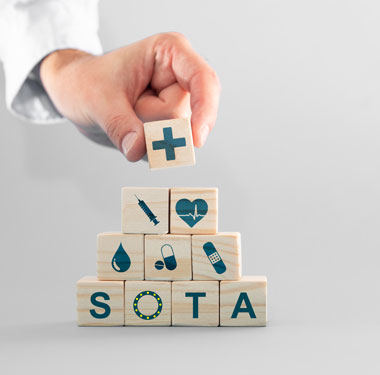The Oxford Dictionary defines “state-of-the-art” as something that belongs or relates to the most recent stage of technological development. It is something that incorporates the newest technology, ideas and features. In short, state-of-the-art means the most advanced, sophisticated, innovative version of a thing.
The European Union’s Medical Device Regulation (MDR) took effect in May 2022, intending to remove ambiguity in medical device manufacturing, alleviate subjective regulatory approvals and prioritize patient safety. To comply with EU legal requirements, any medical device on the market must be considered “state-of-the-art.” Therein lies the problem.
Despite the MDR including the phrase “state-of-the-art” 12 times, the document does not define the concept. In fact, the EU’s Medical Device Coordination Group (MDCG) includes “state-of-the-art” in its list of terms that are explicitly not defined in MDR. Instead, the MDCG refers manufacturers and notified bodies to the definition from the International Medical Device Regulators Forum. It defines state-of-the-art medical devices as those in a “developed stage of current technical capability and/or accepted clinical practice in regard to products, processes, and patient management, based on the relevant consolidated findings of science, technology, and experience.”
The MDCG notes that “state-of-the-art embodies what is currently and generally accepted as good practice in technology and medicine. This state-of-the-art does not necessarily imply the most technologically advanced solution. The state-of-the-art described here is sometimes referred to as the ‘generally acknowledged state-of-the-art’’” Basically, state-of-the-art refers to what the industry generally accepts as good practices. But, the ambiguity of that explanation creates uncertainty for device manufacturers and notified bodies. Manufacturers question whether state-of-the-art refers to the devices, the techniques used to build them, the analytical methods used to test them or the clinical trials they conduct. Meanwhile, notified bodies are left to decide how they define state-of-the-art, based on their grasp of the MDR and EU regulatory law.
The bottom line is that state-of-the-art is a dynamic concept. Exploring MDR verbiage around standards harmonization, risk management and clinical data may allow a clearer understanding of regulatory expectations to emerge.
State-of-the-Art Standards
A harmonized standard is one that has been created by a recognized European standards organization (i.e., CEN, CENELEC or ETSI). Medical device manufacturers and notified bodies can quickly point to harmonized standards to demonstrate that their product, service or process complies with EU legislation. Harmonized standards are considered state-of-the-art.
Specifically, the MDR states: “Devices that are in conformity with the relevant harmonised standards, or the relevant parts of those standards, the references of which have been published in the Official Journal of the European Union, shall be presumed to be in conformity with the requirements of this Regulation covered by those standards or parts thereof.”
Knowing which regulatory guidance to follow becomes more challenging when dealing with non-harmonized standards. Following harmonized standards is voluntary and, in fact, there are only nine of them currently recognized in the EU. Manufacturers and notified bodies can follow whichever technical solution they choose as long as their device complies with EU regulatory law. MDR offers little guidance for manufacturers and notified bodies in these situations. Still, a few best practices can increase the likelihood of finding and following “state-of-the-art” guidance.
First, it is important to note, that only the most recent version of a published standard will qualify as state-of-the-art in the EU. If one of the harmonized standards does not apply to a specific device, manufacturers can seek out published standards that are candidates for harmonization. Alternatively, they can look to international and/or European consensus standards from ISO, IEC or EN for conformity. Published standards from these organizations often provide the framework for MDR harmonized standards and thus reflect current industry thinking.
State-of-the-Art Risk Management
State-of-the-art in medical devices is as much about safety as device performance. MDR Article 10 requires manufacturers to establish, document, implement and maintain a product safety risk management system. The regulation defines risk management as an iterative, long-term process that includes the following requirements:
- Any risks associated with the device must be reduced as far as possible
- Manufacturers must implement a risk management system and apply it to each device
- Risk controls measures must be state-of-the-art
- Risks related to human factors must also be addressed
- Risk mitigation measures must remain effective throughout the life of the device
- Risk mitigation measures must not be affected by transporting or storing the device
- All foreseeable residual risks must be outweighed by the benefits which result from using the device
While informative, the list of requirements does not address state-of-the-art risk management other than to say it is a must-have. An example of using a non-harmonized standard to conform with state-of-the-art risk management may help. Article 10 makes a strong case for chemical characterization using extractables/leachables testing without explicitly referring to the analytical method. It says: “Devices shall be designed, manufactured and packaged in such a way as to minimise the risk posed by contaminants and residues to patients, taking account of the intended purpose of the device, and to the persons involved in the transport, storage and use of the devices. Particular attention shall be paid to tissues exposed to those contaminants and residues and to the duration and frequency of exposure.”
To comply with the guidance laid out above, it’s not uncommon for notified bodies to request physical and/or chemical information as outlined by ISO 10993-1:2018. This is often achieved with chemical characterization data that complies with the revised ISO 10993-18:2020. In the past, manufacturers could use data from literature reviews of their materials to demonstrate risk management, but the heightened focus on advanced chemical analyses has changed that.
MDCG’s article on equivalence specifically references ISO 10993-1:2018, 10993-18:2020 and 10993-17:2002 to recognize the distinction between “same materials or substance” and “similar release characteristics of substances.” The group makes this distinction to account for the fact that designing, manufacturing and transporting medical devices may introduce foreign chemical components even when the raw materials are identical. A literature review would not likely cover these contaminants and residues, which underscores the importance of E/L data from chemical characterization. Even though the EU has not harmonized ISO 10993-18:2020 across all member states, regulators still consider it state-of-the-art.
Still, there seems to be a significant disparity among notified bodies about whether chemical characterization data is necessary. Some notified bodies require it for almost any device—even when it may not be clinically relevant and cannot possibly be supported by using a risk-based approach, like with panels in a clinical setting—and others rarely ask for it. Given the diversity in approach, it is fair to question whether a better understanding of MDR is needed in this area. Manufacturers paying for these additional, and sometimes unnecessary, studies would do well to find out which notified bodies require what before working with one over the other.
State-of-the-Art Clinical Data
Discussing state-of-the-art risk management in medical devices must address similar and equivalent devices. A legally marketed device that is technically, biologically and clinically equivalent to a device being evaluated is considered “equivalent.” Conversely, devices are considered “similar” when they belong to the same generic device group and have the same or similar intended purposes.
When submitting to the U.S. FDA, manufacturers can consult a database of predicate devices that are legally marketed in that country. Data from predicate devices can be used to support a new medical device’s risk claims and streamline regulatory approval. However, no such database exists in the EU. To claim equivalence, manufacturers must have sufficient access to data relating to the equivalent device. For high-risk devices, a contract must be in place allowing full access to the technical documentation on an ongoing basis. These requirements have reduced the possibilities of claiming equivalence in the EU, especially for devices manufactured by third parties.
Moreover, the amount and type of data needed to claim equivalence varies, depending on the device in question. The MDR stresses the importance of clinical data, and clinical investigations (if no equivalence is claimed) can be considered mandatory for implantable and class III devices. A well-conducted clinical evaluation—i.e., one performed according to MEDDEV 2.7/1 Rev 4 and applicable MDCG documents—is essential in addressing whether or not the clinical data is sufficient. Also, support from an experienced biostatistician is essential as notified bodies commonly scrutinize the statistical robustness of the data.
When equivalence cannot be demonstrated, the MDR defines alternative purposes for which “similar” device data can be used. These purposes include:
- To identify relevant hazards and clinical risks
- To understand the state-of-the-art, the natural course of the disease, and alternative available treatment options
- To help define the scope of the clinical evaluation using design features in similar devices that pose special performance or safety concerns
- To provide input for clinical investigation design or post-market clinical follow-up design, and the post-market surveillance system
- To identify relevant and specified clinical outcome parameters for the intended clinical benefits, based on the published clinical data pertaining to the similar device(s)
- To define minimum requirements for a quantified clinical benefit that is considered clinically relevant, and/or to identify acceptable occurrence rates of risks and adverse events
Before gathering clinical data, manufacturers can improve their devices’ trajectories by subjecting them to a full biological evaluation consistent with the ISO 10993 family of standards. Potential risks identified give manufacturers a jumpstart on biocompatibility, simulated-use studies and other targeted analyses that may be necessary before clinical testing. This preclinical data can also be invaluable in substantiating clinical findings when the time comes. Greater collaboration between clinical and preclinical experts will help manufacturers thoroughly manage risk and ensure that only “state-of-the-art” products are available.
A Final Word
Notified bodies are the first and perhaps most important regulatory reviewers when it comes to medical devices. The EU empowers these private organizations to define state-of-the-art according to their experience and grasp of the law, so choosing the right notified body is paramount to achieving regulatory conformity and market success.
But, do remember that what constitutes state-of-the-art today may not apply in 6, 12, or 18 months. The EU wrote the MDR legislation to be dynamic. Its authors wanted the law to grow and change as scientific understanding and industry acceptance evolved. Doing so has created a quandary about how medical devices are evaluated during development and throughout their lifecycles. Device manufacturers longing for access to the EU market are encouraged to closely watch the regulatory landscape, especially at critical stages of product development. Those manufacturers who lack a thorough understanding of MDR would benefit greatly from collaboration with an experienced partner when assessing standards, risk and clinical data.




